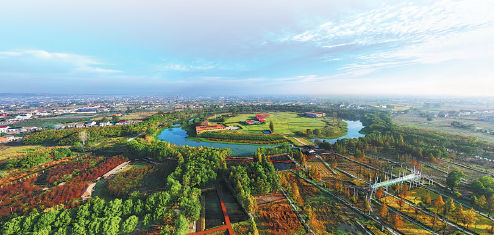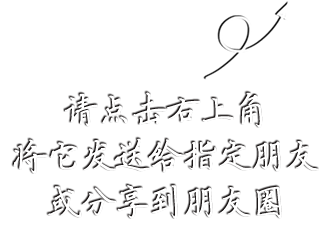
Left: Cao Yi (third from left) from the culture, tourism, radio, television and sports bureau of Lixian county, Hunan province, introduces the moat system of the Chengtoushan site. Middle: An intersecting surface of the city wall of Chengtoushan. Right: Cao points to human remains discovered at the Chengtoushan site in the 1990s.

A bird's-eye view of Chengtoushan national archaeological site park.
Backed by the Wuling Mountains and overlooking Dongting Lake, Liyang Plain in the northwestern part of Central China's Hunan province is not particularly prominent among the country's plains. It spans 700 square kilometers, making it incomparable to vast landmasses such as the North China Plain with an area of 300,000 sq km.
But its significance stems from archaeological perspective. It's home to many prehistoric settlement sites, yielding one of the earliest cities, one of the earliest rice paddy fields and clues for the origins of rice-based agriculture in China.
Since the 1980s, archaeologists have discovered 392 prehistoric cultural sites on this land, with a continuous time sequence from 500,000 to 4,000 years ago. The density and chronological continuity of these prehistoric sites are unparalleled in the history of Chinese archaeology, says Zhou Hua, deputy director of the archaeological research and cultural relics protection center of Lixian county, Hunan, where the major part of Liyang Plain is located.
The large number of sites poses a big challenge to their protection, prompting professionals to employ different strategies to protect and bring them back to life.
A remarkable one is the Bashidang site in Lixian, a settlement site from 10,000 to 8,000 years ago. Covering 48,000 square meters, it is a relatively small-sized site on the plain. Because it boasts significant academic value, people highlight its protection and integrate it carefully with local people's daily life.
In the 1990s, the site yielded 9,800 seeds and husks, a great number at the time, signifying an origin of rice-based agriculture. It also yielded pottery vessels from the transitional period between Paleolithic and Neolithic periods, shedding light on the important time in academic studies.
Now, the site has been built into a park, with most of its area backfilled with rice being planted by local farmers, continuing its role as farmland from thousands of years ago.
"Such plantings do not harm the site since the crops don't take deep roots. Therefore, we can see people have planted crops on this land for such a long time without destroying it. With limited funds, this is the best way we can balance protection and local people's life," says Zhou, who adds that many other sites of a similar scale on the plain are protected in this way.
According to Cao Yi, deputy director of Lixian's culture, tourism, radio, television and sports bureau, they have taken measures that can benefit local people as well. For example, they built roads and bridges in the site to facilitate the transportation, so that the site area has a better environment and farmers can farm more conveniently.
The major threats to the site are the building of homes and tombs and industrial production, which have all been banned. The site is monitored. To keep an eye on the site, they have turned a local residence in the scope into a keeper's office which serves as a rural library as well.
"We invited 68-year-old Zhong Jimu, a retired Party secretary of nearby Wufu village to work as keeper for the site. He manages the site and reports to the cultural heritage authorities if any things happen that shouldn't," says Cao.
"Moreover, we set up a small exhibition about Bashidang's history and significance in the rural library, and bought some children's books and books about farming techniques so that students in a nearby primary school can read and do their homework here after school. Farmers can also find useful books there as well," he adds.
Zhong says the keeper's office is only a five-minute walk from his home.
"Villagers are very interested in cultural relics and believe archaeological excavations can boost the cultural connotations of our hometown," says Zhong.
About 20 km from Bashidang lies the Chengtoushan site which covers 187,000 sq m and has been protected and developed through a different approach.
"If the protection of Bashidang is to combine it with villagers' life, our work to protect and promote Chengtoushan lies mainly in building its brand in local cultural tourism so as to drive other local industries," says Cao.
Dating back 6,500 to 3,800 years, Chengtoushan was one of the earliest cities ever discovered in China, which yielded an ancient paddy field from 6,500 years ago.
"Besides the paddy field, we also found carbonized rice and irrigation facilities, showing a mature agricultural system. Therefore, we infer that ancient people living in Chengtoushan led a relatively stable farming life, different from the earlier lifestyle of hunting and gathering," says Zhou.
A Chengtoushan national archaeological site park has been built at the cost of 600 million yuan ($83.7 million), keeping the original layout, covering 44.13 hectares, with a museum showcasing highlighted cultural artifacts from the site.
Zhou says based on features of the site, they have designed many activities for tourists. For example, they offer people a chance to try their hand at archaeological excavation in the neighboring areas of the site.
People can also plant rice in spring and autumn and catch fish.
They can learn how to make pottery vessels which ancient people also worked on, and row a boat on the river surrounding the settlement.
"Activities should be vivid and various so that people would like to stay," says Zhou.
Moreover, some of the rice people plant has colors, so that when they grow, people can gain a bird's-eye view of the colorful field standing on a bridge straddling two sides of the field.
Cao says they organize activities like straw festivals on the site to promote local agricultural products like rice and grapes.
A highlight of their protection efforts is a project they carried out to protect the city wall, the result of which can be seen in an exhibition hall.
Cao says in a damp environment, soil can deteriorate, discolor, or become moldy.
Taking an intersecting surface unveiled in the archaeological excavation in 1992 for experiments, they explored how to protect it.
"In the 1990s, we tried ways of protecting the surface but could only preserve it for one or two months, and later it continued to deteriorate. In 2016, we wanted to explore if we can protect it with advanced technology," says Cao.
After multiple experiments, they managed to find a way of restoring the wall to its original state and keeping it intact in the long term. The technique won a national prize for protecting cultural relics in 2018 and has provided important reference for the protection of other artifacts.
"Now, the wall has highly similar texture and color compared with the time when newly unearthed, meaning it has been preserved very well," says Cao.
Archaeological progress continues on the Liyang Plain. Archaeologists are excavating the Jijiaocheng site and have found that it was probably an ancient state that rose when Chengtoushan was declining.
"Now, the studies of Jijiaocheng are at the starting point. Covering a stunning area of 10 sq km, it may need a new way for protection and promotion, and that's what we will consider in the next step," says Cao.
Contact the writer at wangru1@chinadaily.com.cn

